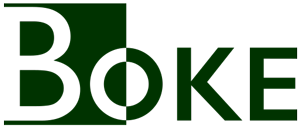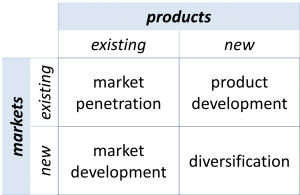Perhaps the most common tool in strategy is the two-by-two matrix. In it, two variables are combined together to produce four possible situations. The Product/Market Matrix is probably the most famous of these:
Created by Igor Ansoff, the father of Strategic Management, in the 1950’s, this matrix invites planners to consider two questions at the same time:
- Should we concentrate selling our current products, or focus on bringing new products to market?
- Should we concentrate on reaching our current market, or focus on reaching new ones?
Depending on how these questions are answered, planners are left with four options for action:
- market penetration – focus on selling our existing products to our current markets
- market development – focus on selling our existing products to new markets
- product development – focus on selling new products to our existing markets
- diversification – focus on selling new products to new markets
 Like the Generic Strategies approach (which it closely resembles), planners considering the Product/Market Matrix are advised to concentrate on only one of these four options at any one time.
Like the Generic Strategies approach (which it closely resembles), planners considering the Product/Market Matrix are advised to concentrate on only one of these four options at any one time.
A firm which tries to pursue more than one of these at the same time, the thinking goes, are likely to send confusing signals to both employees and customers about their priorities. As well, advocates of the Product/Market Matrix often argue that senior managers are not infinitely skilled—a team with skills in market penetration are not likely to also be skilled at diversification.
Although some strategists tend to prefer one of these options over these others, there is no good reason for this. Depending on a firm’s products, markets, and skills, pursuing any one of them can be a recipe for growth.
Applying the Product/Market Matrix
Let’s imagine that we are a restaurant in a small town. Let’s say our town has a population of roughly 1,000. The rural area around us–say within a 20-minute drive–has another 1,000 people. Let’s say there are three similar towns in our larger geographic area–perhaps each 30 to 40 minutes away. And let’s say there is a larger city about 50 minutes away.
Let’s further imagine that we have surveyed our current customers. Virtually all of them report being satisfied with our menu and our service–they believe they receive value for money. About 50% of them live in our town, 40% live in the rural area around us, 8% live in the nearby towns, and 2% live in the larger city.
Finally, let’s say that our average customer comes our restaurant once a month.
How might we apply each of these options to grow our business?
1. Market Penetration
Our primary effort will probably be to increase the number of times per month our current customers come to our restaurant. Can we turn our once-a-month lunch customer into a weekly lunch customer? Can we convince our breakfast regulars to come for an occasional dinner?
We might also consider how we can increase the number of menu items a customer purchases. If someone usually comes in for coffee, how can we convince them to buy a snack as well? If they typically buy a soup and sandwich, can we entice them to add a desert? If they typically come for dinner, how can we increase the likelihood they’ll order wine?
Finally, we might consider how we can draw more customers from our current geographic base. Say we find out that only 40% of our town’s population ever come to our restaurant. What would raise that to 60%?
2. Market Development
If our restaurant pursues this option, we will most likely concentrate on raising our profile in nearby towns and in the large city that’s within driving distance. Although we currently draw a few customers from these locations, they are, in practical terms, new markets.
We might want offer a shuttle service for Saturday night dinners to city-dwellers. We might want to significantly increase our advertising in the nearby towns. We might consider opening a second location in one of those towns. If we believe we have a successful, repeatable formula, we might even consider franchising to other small towns.
3. Product Development
It’s time to grow our menu!
If we’re a diner that primarily draws a lunch crowd, we might add an upscale evening menu. We might consider adding high-end coffees and catering to a mid-morning and mid-afternoon crowd. Or we might hire an early-morning cook and expand our breakfast offerings.
Just as with the market penetration option, this may have the effect of growing our business by increasing how often our current customers come to our restaurant, and expanding what they buy when they visit. And it may have some of the effects of the market development option by increasing the motivation of new customers to drive to our town and try us out.
So the effect may be somewhat the same as the effect of the other two options. But what’s different is our focus. In pursuing the product development option, our primary focus is internally, on expanding our product line.
4. Diversification
Diversification can sometimes be the hardest option to pursue. To produce new products for new customers, we’re going to have to learn new skills.
A small diversification step would see us opening a gas station next door to the restaurant, perhaps with a convenience store attached.
Depending on how radically we want to diversify, the new business might have nothing to do with our restaurant. Perhaps be build a small mall in our town, move our restaurant into it, and rent out the rest of the space. Perhaps we do something that isn’t related to the restaurant at all, but simply use it as a funding source to start the new business.
Choosing
The borders between options are not as cut-and-dried as a 4-box matrix might imply. Is adding a catering service market development or diversification? Is adding a lounge to the restaurant product development or diversification?
Spending too much time debating which box to put an idea into can be a distraction. Better to start by deciding which of the four options might have the most potential for growth, and then considering ideas that seem to roughly fit that option.
Usually, the best way to choose between the options is to consider saturation, opportunities, and competencies.
- Are our current customers saturated with our product? If they are, then market development is going to be essential. If they’re not, convincing current customers to buy from us more is usually the lowest-risk (and highest-payoff) solution.
- Are there opportunities in our market that we we are sure are unmet? Did a competitor shut down? Has a new attraction brought new people to our community? Is there a new product trend that no-one is capitalizing on? If so, then we should be considering fulfilling those opportunities?
- How competent will our firm be at doing new things? Are we stretched already, or do we have untapped skills? If so, then we may well want to develop new products, and might even be ready for diversification.

